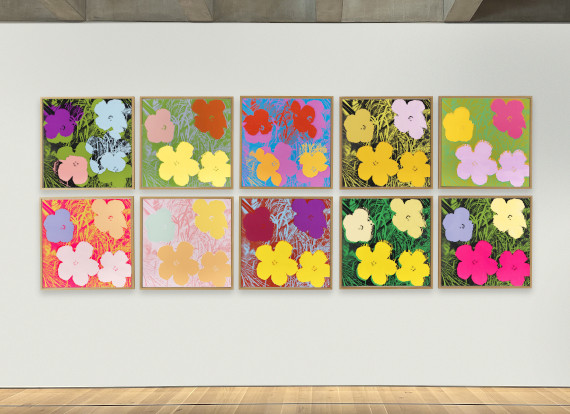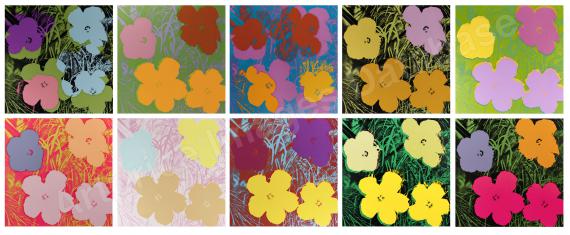Vente: 550 / Evening Sale 07 juin 2024 à Munich  Lot 124000040
Lot 124000040
 Lot 124000040
Lot 124000040
Video
Autre image
Autre image
Autre image
Autre image
Autre image
Autre image
Autre image
Autre image
Autre image
Autre image
Autre image
Autre image
Autre image
124000040
Andy Warhol
Flowers (10 Blatt), 1970.
10 sheet Silkscreen in colors
Estimation: € 800,000 / $ 856,000
Les informations sur la commission d´achat, les taxes et le droit de suite sont disponibles quatre semaines avant la vente.
Flowers (10 Blatt). 1970.
10 sheet Silkscreen in colors.
Each signed and with the stamped number on the reverse, four sheets dated. The complete set of 10 sheets, each copy 86/250. On thin cardboard. Each 91.5 x 91.5 cm (36 x 36 in).
Printed by Aetna Silkscreen Products, Inc., New York. Published by Factory Additions, New York. [EH].
• The complete matching set.
• With their strikingly brilliant colors, Andy Warhol's "Flowers" are among his works that had the greatest impact on the art scene, at the same time they are timeless icons of pop art.
• Alongside "Marilyn" and "Mao", Andy Warhol's famous silkscreen prints "Flowers" are icons of American pop art.
PROVENANCE: Galerie Fetzer, Sontheim a.d. Brenz (through Christie's in 1992)
Private collection Baden-Württemberg (acquired from the above in 2002).
LITERATURE: Frayda Feldman, Jörg Schellmann, Claudia Defendi. Andy Warhol Prints. A catalogue raisonné 1962-1987, New York 2003, no. II.64-73.
--
Christie's, London, Modern and Contemporary Prints, July 3, 1992, lot 631.
10 sheet Silkscreen in colors.
Each signed and with the stamped number on the reverse, four sheets dated. The complete set of 10 sheets, each copy 86/250. On thin cardboard. Each 91.5 x 91.5 cm (36 x 36 in).
Printed by Aetna Silkscreen Products, Inc., New York. Published by Factory Additions, New York. [EH].
• The complete matching set.
• With their strikingly brilliant colors, Andy Warhol's "Flowers" are among his works that had the greatest impact on the art scene, at the same time they are timeless icons of pop art.
• Alongside "Marilyn" and "Mao", Andy Warhol's famous silkscreen prints "Flowers" are icons of American pop art.
PROVENANCE: Galerie Fetzer, Sontheim a.d. Brenz (through Christie's in 1992)
Private collection Baden-Württemberg (acquired from the above in 2002).
LITERATURE: Frayda Feldman, Jörg Schellmann, Claudia Defendi. Andy Warhol Prints. A catalogue raisonné 1962-1987, New York 2003, no. II.64-73.
--
Christie's, London, Modern and Contemporary Prints, July 3, 1992, lot 631.
The Flowers portfolio containing 10 large silkscreens in radiant colors by Andy Warhol was published in 1970. The artist discovered trhe motif in the important year 1964, and he remained preoccupied with the Flowers ever since.
Why was the year of 1964 so important? In the summer, Andy Warhol joined Leo Castelli, who undoubtedly ran one of the most important galleries for contemporary art in the USA at the time. He had signed artists such as Jasper Johns, Robert Rauschenberg and Claes Oldenburg, alongside luminaries of Abstract Expressionism like De Kooning and Jackson Pollock. Andy Warhol had his first Castelli show between September 26 and October 22, 1964. Exhibiting his work alongside Richard Artschwager, Roy Lichtenstein, James Rosenquist and Frank Stella. His first solo exhibition "Andy Warhol. Flower Paintings" followed in November (November 21 - December 28, 1964) - and was a great success.
Andy Wahol, son of Eastern European immigrants, grew up in humble circumstances. He pursued a career as a commercial artist, designing shop windows, creating ads and greeting cards for New York department stores such as Tiffany. The money he earned enabled him to focus on his passion for art. With his Brillo Boxes and Campbell Soup pictures, elevating consumer goods to art objects, he introduced a new concept into contemporary art. This was not only a new aesthetic, he also took a new and questioning look at US consumerism and its beauty - an entirely new view of American society. With series such as "Electric Chair" and "Most Wanted Men", he also addressed social topics. As he was already a sought-after portraitist at the time, many people wanted to be portrayed by him, not least because of his "Marilyn Monroe" and "Jackie" series. These portraits are based on photographs, which he alienated using his innovative silkscreen technique in combination with painting.
The "Flowers" are also based on a photograph. A photograph of 7 hibiscus blossoms he came across in the magazine Modern Photography. The shot was taken by Patricia Caulfield, and the accompanying article discussed new ways of developing slides using a specific process that Kodak had invented. Andy Warhol reduced this photo to a square section of 4 blossoms, sharpened the contrasts and played with the colors.
The square format also enabled him to do something else: fill the wall space. The pictures are placed across the wall in a dense arrangement. In 1964 and 65, he had several shows with "Flowers" in various sizes at Castelli in New York and at Ilana Sonnabend in Paris. An exhibition photo taken at Sonnabend Gallery in Paris in 1965 shows how the "Flowers" can be presented in a variety of ways: the series of 5-inch pictures are hung diagonally on top of each other or as a flat, rectangular block.
This serial work is an essential feature of his understanding of art. In small variations, for example by rotating a motif or changing the color, he gives the objects new individuality through reproduction and repetition.
One year after he had adapted the "Flowers" photo, Andy Warhol decided to stop painting. He only wanted to film. The medium of video had captured him and he also intensively explored the potential of printmaking. Introducing a number of new technical variations, Andy Warhol was one of the most innovative minds in this field. He devoted his most important projects to print portfolios. "Marilyn Monroe" appeared in 1967, "Campbell's Soup" in 1968/69 and, finally, the 10-sheet set "Flowers" in 1970. In "Flowers", Andy Warhol combined the characteristics of the serial approach he had previously established. The 10 "Flowers" depictions vary in orientation and color scheme. Shifts in the color stencils are also integrated. This portfolio thus presents itself as a summary of his fundamental artistic ideas.
Complete matching sets, meaning a series of 10 sheets with the same copy number, are extremely rare on the market. Our copy has been part of a German private collection for over 30 years.
Patrica Caulfield, the author of the photo, sued Warhol for copyright infringement in 1966. The two adversaries reached a settlement: Warhol created two new Flowers paintings for her and "agreed to pay her a 25 percent share of the royalties derived from a portfolio of "Flowers" prints" (quoted from: https://www.nytimes.com/2023/09/07/arts/patricia-caulfield-dead.html)
Why was the year of 1964 so important? In the summer, Andy Warhol joined Leo Castelli, who undoubtedly ran one of the most important galleries for contemporary art in the USA at the time. He had signed artists such as Jasper Johns, Robert Rauschenberg and Claes Oldenburg, alongside luminaries of Abstract Expressionism like De Kooning and Jackson Pollock. Andy Warhol had his first Castelli show between September 26 and October 22, 1964. Exhibiting his work alongside Richard Artschwager, Roy Lichtenstein, James Rosenquist and Frank Stella. His first solo exhibition "Andy Warhol. Flower Paintings" followed in November (November 21 - December 28, 1964) - and was a great success.
Andy Wahol, son of Eastern European immigrants, grew up in humble circumstances. He pursued a career as a commercial artist, designing shop windows, creating ads and greeting cards for New York department stores such as Tiffany. The money he earned enabled him to focus on his passion for art. With his Brillo Boxes and Campbell Soup pictures, elevating consumer goods to art objects, he introduced a new concept into contemporary art. This was not only a new aesthetic, he also took a new and questioning look at US consumerism and its beauty - an entirely new view of American society. With series such as "Electric Chair" and "Most Wanted Men", he also addressed social topics. As he was already a sought-after portraitist at the time, many people wanted to be portrayed by him, not least because of his "Marilyn Monroe" and "Jackie" series. These portraits are based on photographs, which he alienated using his innovative silkscreen technique in combination with painting.
The "Flowers" are also based on a photograph. A photograph of 7 hibiscus blossoms he came across in the magazine Modern Photography. The shot was taken by Patricia Caulfield, and the accompanying article discussed new ways of developing slides using a specific process that Kodak had invented. Andy Warhol reduced this photo to a square section of 4 blossoms, sharpened the contrasts and played with the colors.
The square format also enabled him to do something else: fill the wall space. The pictures are placed across the wall in a dense arrangement. In 1964 and 65, he had several shows with "Flowers" in various sizes at Castelli in New York and at Ilana Sonnabend in Paris. An exhibition photo taken at Sonnabend Gallery in Paris in 1965 shows how the "Flowers" can be presented in a variety of ways: the series of 5-inch pictures are hung diagonally on top of each other or as a flat, rectangular block.
This serial work is an essential feature of his understanding of art. In small variations, for example by rotating a motif or changing the color, he gives the objects new individuality through reproduction and repetition.
One year after he had adapted the "Flowers" photo, Andy Warhol decided to stop painting. He only wanted to film. The medium of video had captured him and he also intensively explored the potential of printmaking. Introducing a number of new technical variations, Andy Warhol was one of the most innovative minds in this field. He devoted his most important projects to print portfolios. "Marilyn Monroe" appeared in 1967, "Campbell's Soup" in 1968/69 and, finally, the 10-sheet set "Flowers" in 1970. In "Flowers", Andy Warhol combined the characteristics of the serial approach he had previously established. The 10 "Flowers" depictions vary in orientation and color scheme. Shifts in the color stencils are also integrated. This portfolio thus presents itself as a summary of his fundamental artistic ideas.
Complete matching sets, meaning a series of 10 sheets with the same copy number, are extremely rare on the market. Our copy has been part of a German private collection for over 30 years.
Patrica Caulfield, the author of the photo, sued Warhol for copyright infringement in 1966. The two adversaries reached a settlement: Warhol created two new Flowers paintings for her and "agreed to pay her a 25 percent share of the royalties derived from a portfolio of "Flowers" prints" (quoted from: https://www.nytimes.com/2023/09/07/arts/patricia-caulfield-dead.html)
124000040
Andy Warhol
Flowers (10 Blatt), 1970.
10 sheet Silkscreen in colors
Estimation: € 800,000 / $ 856,000
Les informations sur la commission d´achat, les taxes et le droit de suite sont disponibles quatre semaines avant la vente.






